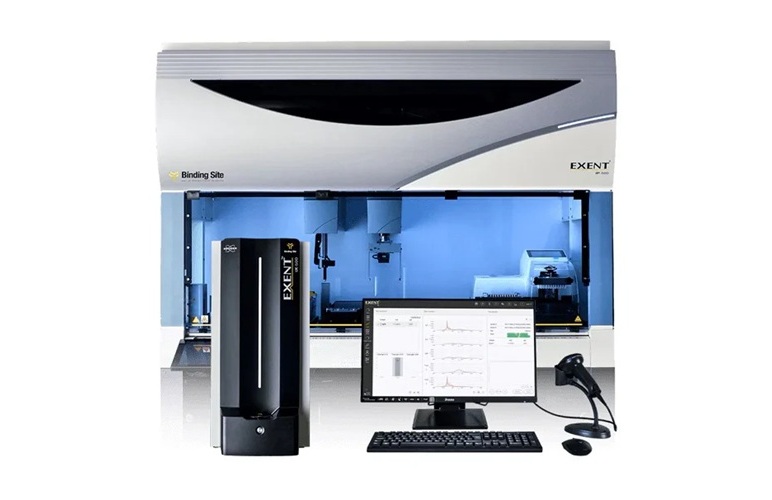Blood Culture Diagnostic Techniques Compared for Human Brucellosis
|
By LabMedica International staff writers Posted on 16 Apr 2014 |

Image: Scanning electron micrograph of Brucella abortus (Photo courtesy of the Czech University of Life Science).
Isolation of the bacteria Brucella is the gold standard in the laboratory diagnosis of brucellosis and as the organism is intracellular, the number of circulating bacteria is usually low.
Three different blood culture methods, the lysis concentration (LC), clot culture and conventional Castaneda blood culture techniques, have been compared for the isolation rate and recovery time in the diagnosis of human brucellosis.
Microbiologists at the Shri B. M. Patil Medical College (Bijapur, Karnataka, India) performed blood cultures by LC, clot culture and conventional method in 169 patients who had antibody titers equal to or greater than 160 international units by the serum agglutination test (SAT).
For the conventional culture technique, the blood specimen was inoculated aseptically into the broth phase of Castaneda's biphasic medium consisting of brain heart infusion agar and broth with Brucella selective supplement (Hi-Media; Mumbai, India). For the LC technique, the mixtures centrifuged and the supernatant was discarded and the sediment was inoculated in the Castaneda's medium, instead of culture plate.
For the clot culture technique, the blood clot was preserved in the sterile screw capped plastic tube with glass beads after removal of serum was used for this method. The clot was disrupted by shaking the tubes on a shaker for 15 minutes and the disrupted clot was then inoculated in Castaneda's medium. The media were incubated at 37 °C with 10% carbon dioxide for a maximum of 30 days. Provisional confirmation and biotyping of the isolate was done by performing slide agglutination test using B. abortus and B. melitensis monospecific antisera (Murex Biotech; Dartford, UK).
Overall blood culture positivity was found to be 24.8% by conventional culture, 34.9% by clot method, and 43.1% by the lysis technique. The mean recovery time by lysis and clot culture techniques was significantly less than conventional method, resulting in an overall difference of nearly six and four days respectively.
The authors concluded that for the isolation of Brucella from blood specimen, LC method is better than conventional Castaneda's method as the isolation rate is high and the recovery time is less. Clot culture is a better option when a second blood sample cannot be obtained for culture. As lysis and clot culture techniques are sensitive, simple and inexpensive and yield earlier results, they can be adapted in the technically and economically deprived areas where automated systems are not feasible. The study was published on March 19, 2014, in the Journal of Laboratory Physicians.
Related Links:
Shri B. M. Patil Medical College
Hi-Media
Murex Biotech
Three different blood culture methods, the lysis concentration (LC), clot culture and conventional Castaneda blood culture techniques, have been compared for the isolation rate and recovery time in the diagnosis of human brucellosis.
Microbiologists at the Shri B. M. Patil Medical College (Bijapur, Karnataka, India) performed blood cultures by LC, clot culture and conventional method in 169 patients who had antibody titers equal to or greater than 160 international units by the serum agglutination test (SAT).
For the conventional culture technique, the blood specimen was inoculated aseptically into the broth phase of Castaneda's biphasic medium consisting of brain heart infusion agar and broth with Brucella selective supplement (Hi-Media; Mumbai, India). For the LC technique, the mixtures centrifuged and the supernatant was discarded and the sediment was inoculated in the Castaneda's medium, instead of culture plate.
For the clot culture technique, the blood clot was preserved in the sterile screw capped plastic tube with glass beads after removal of serum was used for this method. The clot was disrupted by shaking the tubes on a shaker for 15 minutes and the disrupted clot was then inoculated in Castaneda's medium. The media were incubated at 37 °C with 10% carbon dioxide for a maximum of 30 days. Provisional confirmation and biotyping of the isolate was done by performing slide agglutination test using B. abortus and B. melitensis monospecific antisera (Murex Biotech; Dartford, UK).
Overall blood culture positivity was found to be 24.8% by conventional culture, 34.9% by clot method, and 43.1% by the lysis technique. The mean recovery time by lysis and clot culture techniques was significantly less than conventional method, resulting in an overall difference of nearly six and four days respectively.
The authors concluded that for the isolation of Brucella from blood specimen, LC method is better than conventional Castaneda's method as the isolation rate is high and the recovery time is less. Clot culture is a better option when a second blood sample cannot be obtained for culture. As lysis and clot culture techniques are sensitive, simple and inexpensive and yield earlier results, they can be adapted in the technically and economically deprived areas where automated systems are not feasible. The study was published on March 19, 2014, in the Journal of Laboratory Physicians.
Related Links:
Shri B. M. Patil Medical College
Hi-Media
Murex Biotech
Latest Microbiology News
- Rapid Assay Identifies Bloodstream Infection Pathogens Directly from Patient Samples
- Blood-Based Molecular Signatures to Enable Rapid EPTB Diagnosis
- 15-Minute Blood Test Diagnoses Life-Threatening Infections in Children
- High-Throughput Enteric Panels Detect Multiple GI Bacterial Infections from Single Stool Swab Sample
- Fast Noninvasive Bedside Test Uses Sugar Fingerprint to Detect Fungal Infections
- Rapid Sepsis Diagnostic Device to Enable Personalized Critical Care for ICU Patients
- Microfluidic Platform Assesses Neutrophil Function in Sepsis Patients
- New Diagnostic Method Confirms Sepsis Infections Earlier
- New Markers Could Predict Risk of Severe Chlamydia Infection
- Portable Spectroscopy Rapidly and Noninvasively Detects Bacterial Species in Vaginal Fluid
- CRISPR-Based Saliva Test Detects Tuberculosis Directly from Sputum
- Urine-Based Assay Diagnoses Common Lung Infection in Immunocompromised People
- Saliva Test Detects Implant-Related Microbial Risks
- New Platform Leverages AI and Quantum Computing to Predict Salmonella Antimicrobial Resistance
- Early Detection of Gut Microbiota Metabolite Linked to Atherosclerosis Could Revolutionize Diagnosis
- Viral Load Tests Can Help Predict Mpox Severity
Channels
Clinical Chemistry
view channel
Chemical Imaging Probe Could Track and Treat Prostate Cancer
Prostate cancer remains a leading cause of illness and death among men, with many patients eventually developing resistance to standard hormone-blocking therapies. These drugs often lose effectiveness... Read more
Mismatch Between Two Common Kidney Function Tests Indicates Serious Health Problems
Creatinine has long been the standard for measuring kidney filtration, while cystatin C — a protein produced by all human cells — has been recommended as a complementary marker because it is influenced... Read moreMolecular Diagnostics
view channel
Blood Test to Help Low-Risk Gastric Cancer Patients Avoid Unnecessary Surgery
Accurately identifying lymph node metastasis in early-stage gastric cancer remains a major clinical challenge. CT imaging often misses up to half of lymph node–positive cases, leading clinicians to recommend... Read more
First-Of-Its-Kind Automated System Speeds Myeloma Diagnosis
More than 176,000 people are diagnosed with multiple myeloma worldwide each year, yet the current diagnostic pathway can be slow and uncertain, often relying on a highly subjective interpretation of test results.... Read moreHematology
view channel
Platelet Activity Blood Test in Middle Age Could Identify Early Alzheimer’s Risk
Early detection of Alzheimer’s disease remains one of the biggest unmet needs in neurology, particularly because the biological changes underlying the disorder begin decades before memory symptoms appear.... Read more
Microvesicles Measurement Could Detect Vascular Injury in Sickle Cell Disease Patients
Assessing disease severity in sickle cell disease (SCD) remains challenging, especially when trying to predict hemolysis, vascular injury, and risk of complications such as vaso-occlusive crises.... Read more
ADLM’s New Coagulation Testing Guidance to Improve Care for Patients on Blood Thinners
Direct oral anticoagulants (DOACs) are one of the most common types of blood thinners. Patients take them to prevent a host of complications that could arise from blood clotting, including stroke, deep... Read moreImmunology
view channel
Gene Signature Test Predicts Response to Key Breast Cancer Treatment
DK4/6 inhibitors paired with hormone therapy have become a cornerstone treatment for advanced HR+/HER2– breast cancer, slowing tumor growth by blocking key proteins that drive cell division.... Read more
Chip Captures Cancer Cells from Blood to Help Select Right Breast Cancer Treatment
Ductal carcinoma in situ (DCIS) accounts for about a quarter of all breast cancer cases and generally carries a good prognosis. This non-invasive form of the disease may or may not become life-threatening.... Read morePathology
view channel
AI Tool Outperforms Doctors in Spotting Blood Cell Abnormalities
Diagnosing blood disorders depends on recognizing subtle abnormalities in cell size, shape, and structure, yet this process is slow, subjective, and requires years of expert training. Even specialists... Read more
AI Tool Rapidly Analyzes Complex Cancer Images for Personalized Treatment
Complex digital biopsy images that typically take an expert pathologist up to 20 minutes to assess can now be analyzed in about one minute using a new artificial intelligence (AI) tool. The technology... Read moreTechnology
view channel
AI Saliva Sensor Enables Early Detection of Head and Neck Cancer
Early detection of head and neck cancer remains difficult because the disease produces few or no symptoms in its earliest stages, and lesions often lie deep within the head or neck, where biopsy or endoscopy... Read more
AI-Powered Biosensor Technology to Enable Breath Test for Lung Cancer Detection
Detecting lung cancer early remains one of the biggest challenges in oncology, largely because current tools are invasive, expensive, or unable to identify the disease in its earliest phases.... Read moreIndustry
view channel
Abbott Acquires Cancer-Screening Company Exact Sciences
Abbott (Abbott Park, IL, USA) has entered into a definitive agreement to acquire Exact Sciences (Madison, WI, USA), enabling it to enter and lead in fast-growing cancer diagnostics segments.... Read more




 assay.jpg)



















